1. Display Devices
Currently, the display products on the market mainly include: Cathode Ray Tube (CRT) displays and Liquid Crystal Displays (LCD).
Cathode Ray Tube (Old TV)
CRT displays are scientifically named “Cathode Ray Tube”, which is a type of display that uses a cathode ray tube. It mainly consists of five parts: electron gun, deflection coils, shadow mask, high-voltage graphite electrode, and phosphor coating with a glass shell. It is one of the most widely used displays..
[CRT Display Working Principle]
Electric or magnetic fields gather the electrons emitted by the cathode into a beam while controlling their direction of movement, sequentially bombarding different areas of the phosphor to make it glow. The display image we see is the corresponding optical signal that converts the video electrical signal applied to the electron gun grid or cathode into brightness that varies spatially according to the signal strength, thus obtaining an optical image that is geometrically similar to the original scene and meets the visual characteristics required by the human eye. Left Image: Internal structure of a TV; Right Image:CRT display internal structure diagram
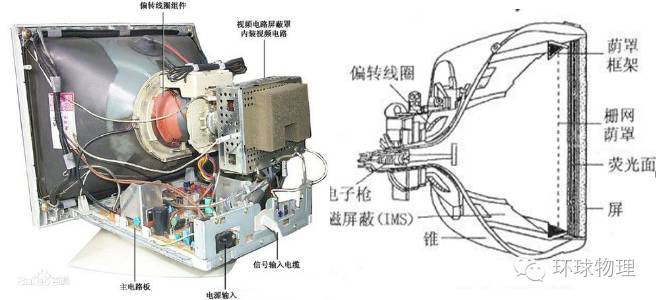
CRT displays use electron beams to control and represent the principle of the three primary colors. The working principle of the electron gun is that the filament heats the cathode, which emits electrons, and then under the action of the electric field of the acceleration electrode, focuses into a very fine electron beam. Under the action of high voltage on the anode, it gains enormous energy and strikes the phosphor layer at extremely high speed. The target of these electron beams is the three primary colors on the phosphor screen.
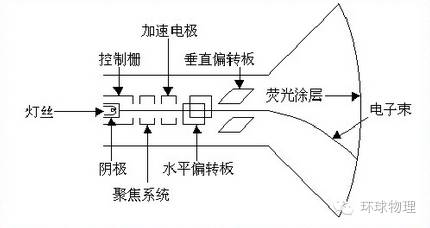
Image3:Working principle diagram of CRT display electron gun
[Color CRT Display Principle]
The appearance of color CRTs is similar to that of black-and-white cathode ray tubes, also composed of electron guns, phosphor screens, and other components, but their internal structure is much more complex. The electron gun of the color cathode ray tube emits not one beam, but three beams, and uses these three beams to sequentially bombard their respective three primary color phosphor units, thus achieving color image display through the principle of superimposing three primary colors.
1) Electron Beam Penetration Method
Utilizing the characteristic that the emission color and brightness of some luminescent materials change with the variation of external excitation voltage or current, to achieve multi-color display. A single electron beam can be used, with the instantaneous acceleration voltage changed to make the electron beam strike different powder layers sequentially to display different colors; or three electron beams can be used, applying different acceleration voltages to each beam to strike different powder layers and display different colors.
2) Shadow Mask Method
The shadow mask is an ultra-thin steel sheet installed inside the cathode ray tube, with more than 400,000 micro-holes etched on it. Inside the color cathode ray tube, the shadow mask is installed between the glass shell and the electron gun, serving a color separation function. In other words, without the shadow mask, there would be no CRT color TVs widely used today. Each light spot in the inner layer of the CRT phosphor screen is arranged in a certain form of three colors: red, green, and blue, with three very small and closely spaced phosphor dots. The color of the screen light spot depends on the colors of the three phosphor dots and their mixed color. Shadow masks can be divided into two types: hole-type shadow masks and stripe-type shadow masks. Theoretically, hole-type shadow mask displays images accurately and are relatively low in cost, suitable for general applications; stripe-type shadow mask displays are brighter in color and have higher transmittance, resulting in more vivid image colors. They are more suitable for professional applications such as multimedia graphics and images.
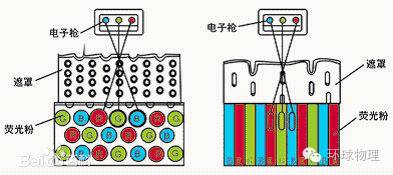 Image4: Shadow mask working principle
Image4: Shadow mask working principle
2. Liquid Crystal Displays
1、Classification of Liquid Crystal Molecules:
1) Nematic Liquid Crystals: Their molecules are rod-shaped, and in some areas, the molecules tend to align in the same direction. The short-range interactions between molecules are relatively weak, and their arrangement and movement are relatively free. This arrangement state gives them low viscosity and strong fluidity. The main characteristic of nematic liquid crystals is that they have uniaxial crystal optical properties and are very sensitive to external influences, making them the main material for liquid crystal display devices.
2) Smectic Liquid Crystals: Smectic liquid crystal molecules are also rod-shaped, arranged in layers, with the long axes of the molecules in each layer aligned in the same direction, but at a certain angle to the layer plane. The thickness of the layers is approximately equal to the length of the molecules, and the distance between layers can vary. Due to the strong binding force within the layers and weak binding force between layers, this type of liquid crystal has fluidity but a higher viscosity than nematic liquid crystals. Smectic liquid crystals exhibit positive birefringence, thus smectic liquid crystal display devices have superior characteristics compared to nematic liquid crystal display devices.
3) Cholesteric Liquid Crystals: Their molecules are arranged in a flat layered structure, with the long axes of the molecules parallel to the layer plane. The long axes of adjacent layers have a slight twist angle, and the molecular orientation continuously rotates along the normal direction of the layer, forming a helical structure in the liquid crystal. The distance between two layers with a 360° twist is called the pitch. This special helical structure gives this type of crystal significant optical properties such as optical rotation, circularly polarized light dichroism, and selective light scattering. Therefore, cholesteric liquid crystals are often used as additives to control the arrangement of liquid crystal molecules or as color-changing liquid crystal films.
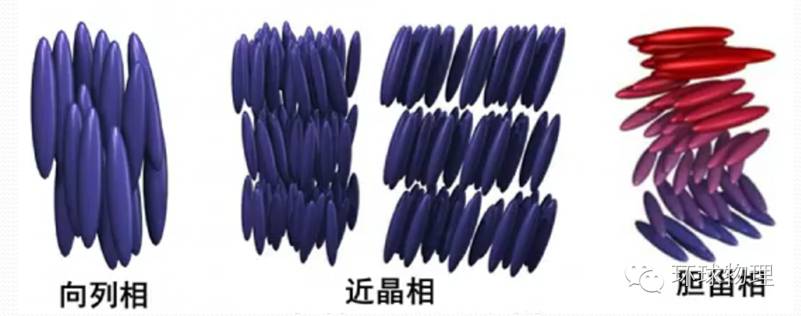
Image5: Classification of Liquid Crystal Molecules
2、Working Principle of Liquid Crystal Displays
The working principle of liquid crystal displays is: When electricity is applied, the liquid crystal arrangement becomes orderly, allowing light to pass through; when electricity is not applied, the arrangement becomes chaotic, preventing light from passing through. Below are three types of liquid crystal display working principles.
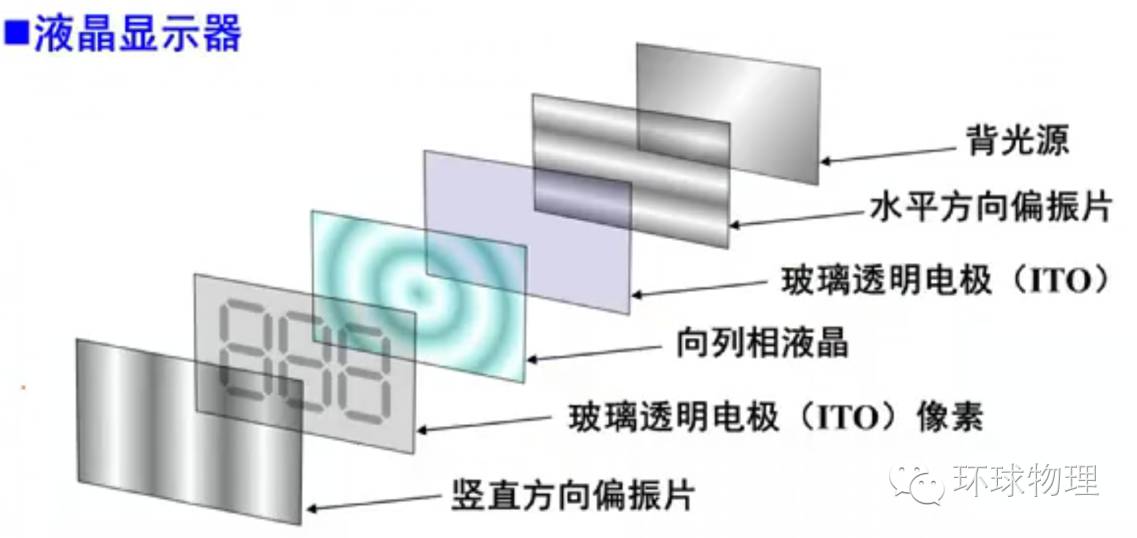
Image6: Working principle diagram of liquid crystal displays
(1). TN Type Liquid Crystal Display Principle
TN type liquid crystal display technology can be said to be the most basic among liquid crystal displays, and other types of liquid crystal displays can be said to be improved based on the TN type. Its operating principle is also simpler than other technologies. Please refer to the image below. The image shows a simple structure diagram of the TN type liquid crystal display, which includes vertical and horizontal polarizers, alignment films with fine grooves, liquid crystal material, and conductive glass substrates. Without an electric field, incident light passes through the polarizer and through the liquid crystal layer, the polarization is rotated 90 degrees by the liquid crystal layer aligned according to the molecular grooves, and when it exits the liquid crystal layer, its polarization direction coincides with that of the other polarizer, allowing light to pass smoothly and making the entire electrode surface bright. When an electric field is applied, the optical axis of each liquid crystal molecule aligns with the direction of the electric field, causing the liquid crystal layer to lose its twisting ability, resulting in the polarization direction of the incident light being perpendicular to the polarization direction of the other polarizer, thus preventing light from passing through, and the electrode surface appears dark. The imaging principle is that the liquid crystal material is placed between two transparent conductive glass plates with perpendicular polarizers, and the liquid crystal molecules will rotate according to the direction of the grooves of the alignment film. If no electric field is formed, light will pass smoothly from the polarizer, following the direction of rotation of the liquid crystal molecules, and then exit from the other side. If an electric field is applied between the two conductive glasses, an electric field will be created that affects the arrangement of the liquid crystal molecules, causing them to twist, thus blocking the light source. This phenomenon of light and dark contrast is called twisted nematic field effect, abbreviated as TNFE. Almost all liquid crystal displays used in electronic products are made using the twisted nematic field effect principle..
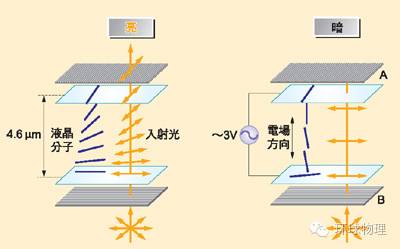
Image7: TN Type Liquid Crystal Display Principle Diagram
(2).STN Liquid Crystal Display Principle
The STN display principle is similar to TN, except that TN twisted nematic field effect liquid crystal molecules rotate the incident light by 90 degrees, while STN super twisted nematic field effect rotates the incident light by 180~270 degrees. It should be noted that a pure TN liquid crystal display itself can only display two conditions (black and white), and cannot achieve color variation. However, the STN liquid crystal display involves the relationship of liquid crystal materials and the phenomenon of light interference, so the displayed tones are mainly light green and orange. However, if a color filter is added to the traditional monochrome STN liquid crystal display, and any pixel in the monochrome display matrix is divided into three sub-pixels, displaying red, green, and blue primary colors through the color filter, and then blending the three primary colors, it can also display full-color mode. Additionally, if the TN type liquid display screen is made larger, its contrast will appear poorer, but the improvement technology of STN can compensate for the lack of contrast.
(3). TFT Type Liquid Crystal Display
The TFT type liquid crystal display is more complex, primarily composed of a fluorescent tube, light guide plate, polarizer, filter, glass substrate, alignment film, liquid crystal material, thin film transistors, etc. First, the liquid crystal display must use a backlight source, which is a fluorescent lamp that projects light. This light source first passes through a polarizer and then through the liquid crystal. At this point, the arrangement of the liquid crystal molecules changes, altering the angle of the light passing through the liquid crystal. The light must then pass through a color filter and another polarizer in front. Therefore, by changing the voltage value that stimulates the liquid crystal, we can control the intensity and color of the light that ultimately appears, thus allowing the liquid crystal panel to display different shades of color combinations.
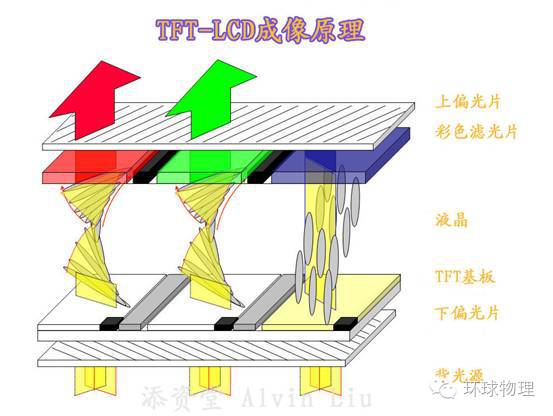
Image8: TFT Liquid Crystal Display Principle
Under the action of the electric field, the arrangement direction of the liquid crystal molecules changes, resulting in a change in the transmittance of the external light source (modulation), completing the electric-optical conversion, and then usingR, G, B three primary color signals to complete the temporal and spatial color reproduction through red, green, and blue color filters. Unlike CRT color cathode ray tubes, it uses digital addressing and digital signal excitation to reproduce images.
To Be Continued!
This issue editor|Ether
Global Physics makes physics simpler!!! Professional physics, dedicated to physics! If you need to improve your physics, you can call Global Physics at the following numbers for consultation: 010-56143955, 010-56143855, 400-808-9005
Address: 55 Suzhou Street, Haidian District, Beijing, Ming Shang Building 1101A
Website: www.huanqiuwuli.com
